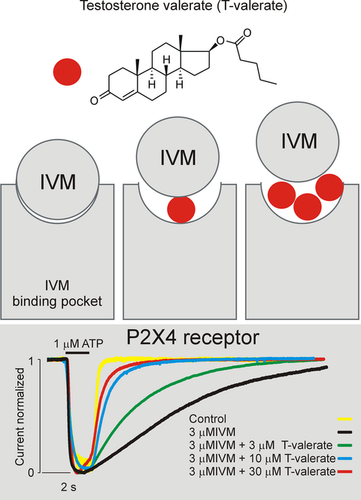Synthetic testosterone derivatives modulate rat P2X2 and P2X4 receptor channel gating
Latest updated: February 21, 2022Sonja Sivcev, Barbora Slavikova, Marian Rupert, Milorad Ivetic, Michaela Nekardova, Eva Kudova, Hana Zemkova
Journal of Neurochemistry, Volume150, Issue1, July 2019,Pages 28-43
Abstract
P2X receptors (P2XRs) are ATP‐gated cationic channels that are allosterically modulated by numerous compounds, including steroids and neurosteroids. These compounds may both inhibit and potentiate the activity of P2XRs, but sex steroids such as 17β‐estradiol or progesterone are reported to be inactive. Here, we tested a hypothesis that testosterone, another sex hormone, modulates activity of P2XRs. We examined actions of native testosterone and a series of testosterone derivatives on the gating of recombinant P2X2R, P2X4R and P2X7R and native channels expressed in pituitary cells and hypothalamic neurons. The 17β‐ester derivatives of testosterone rapidly and positively modulate the 1 µM ATP‐evoked currents in P2X2R‐ and P2X4R‐expressing cells, but not agonist‐evoked currents in P2X7R‐expressing cells. In general, most of the tested testosterone derivatives are more potent modulators than endogenous testosterone. The comparison of chemical structures and whole‐cell recordings revealed that their interactions with P2XRs depend on the lipophilicity and length of the alkyl chain at position C‐17. Pre‐treatment with testosterone butyrate or valerate increases the sensitivity of P2X2R and P2X4R to ATP by several fold, reduces the rate of P2X4R desensitization, accelerates resensitization, and enhances ethidium uptake by P2X4R. Native channels are also potentiated by testosterone derivatives, while endogenously expressed GABA receptors type A are inhibited. The effect of ivermectin, a P2X4R‐specific allosteric modulator, on deactivation is antagonized by testosterone derivatives in a concentration‐dependent manner. Together, our results provide evidence for potentiation of particular subtypes of P2XRs by testosterone derivatives and suggest a potential role of ivermectin binding site for steroid‐induced modulation.
